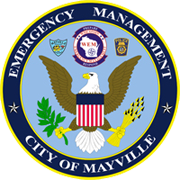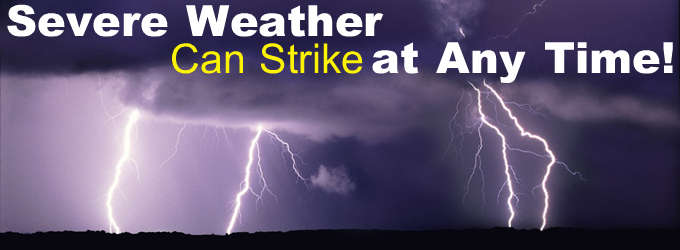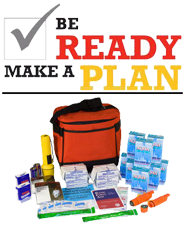

Mayville Emergency Management
Welcome to the City of Mayville Emergency Government Webpage. Our goal is to protect life and property during emergency and disaster situations by providing citizens with information needed to safeguard themselves in the event of an emergency. The Mayville Emergency Government coordinates efforts to prevent injuries and save lives, protect property, secure critical infrastructure and facilities and resume public safety operations efficiently.
Each year, roughly 23 tornadoes touch down in Wisconsin. Your safety depends on being alert and cautious. Be sure that you understand the difference between a tornado watch and warning. A Watch means, “Watch” the sky. Weather conditions are right for tornadoes to form. A Warning means a tornado has been sighted.TAKE COVER IMMEDIATELY! Seek shelter in your basement. If you don’t have a basement, go to a bathroom or closet with no windows on the first floor. Remember to cover and protect your head. For more safety tips, contact your county emergency management director.
Do you know what to do in the event of severe weather? Families, schools, and businesses should have an emergency plan in case of threatening weather. This includes knowing where to go for shelter, what to do if severe weather strikes, have a NOAA Weather Radio to monitor conditions, and put together a Disaster Supplies Kit that contains a flashlight with fresh batteries, bottled water, a first aid kit, and blankets. Remember your safety depends upon knowing what to do should a severe storm strike. For more safety information, contact your county emergency management director.
What to do before Severe Weather Strikes
Before the Storm
- Develop a plan for you and your family for home, work, school and outdoors.
- Have frequent drills.
- Know the county/township in which you live, and keep a highway map nearby to follow storm movement from weather bulletins.
- Have a NOAA Weather Radio with a warning alarm tone and battery back-up to receive warnings.
- Listen to local radio and television stations for further information.
A Disaster Supply Kit would Include
- Water (1 gallon per person per day for 3 days)
- Food that does not need electricity for storage or preparation
- Manual can opener (if kit contains canned food)
- Battery-powered NOAA Weather Radio and a commercial radio or hand crank radio
- Flashlights and extra batteries
- Sleeping bag or warm blanket for each person
- First aid kit and emergency medical reference manual
- Prescription medications and eyewear
- Mess kits, paper cups, plates and plastic utensils, paper towels, moist towelettes, garbage bags and ties
- Complete change of clothing, including a long-sleeved shirt, long pants, socks and sturdy shoes
For Baby
- Formula
- Bottled water to mix with formula and to wash bottles
- Bottles
- Blankets (both emergency blankets and receiving blankets)
- Diapers – keep the diaper size current
- Disposable wipes
- Copy of a current shot record
- Bath towels and wash cloths
- Burp cloths, bibs
- Cotton swabs
- Medications
- Diaper rash ointment
- Binkies and toys
- Cotton swabs
- Medications
- Diaper rash ointment
For Pets
- Identification tags on collars
- Medications, immunization records
- Food, drinking water, bowls, cat litter/pan and can opener
- Sturdy leashes or carriers to transport pets safely (Carriers should be large enough for the pet to stand up, turn around and lie down)
- Towels or blankets
- Current photos of you with your pets
- Feeding schedules, medical conditions, behavior problems, and the name and number of your veterinarian
- Pet beds and toys
Additional Items
- Cash in small denominations or traveler's checks and change
- Copies of important family documents, such as insurance policies, identification and bank account records in a waterproof, portable container
- Wrench or pliers to turn off utilities
- Matches in a waterproof container
- Household chlorine bleach and medicine dropper (When diluted nine parts water to one part bleach it can be used to disinfect)
- Dust mask (to help filter contaminated air) and plastic sheeting/duct tape (to shelter where you are)
- Local maps
- Books, games, puzzles or other activities for children
- Paper and pencil
- Fire Extinguisher
- Whistle to signal for help
WHAT TO DO WHEN SEVERE WEATHER STRIKES
WATCHES AND WARNINGS
TORNADO WATCH: Conditions are favorable for the development of tornadoes in your area. Remain alert for approaching storms.
TORNADO WARNING: A tornado is imminent (based on weather radar information) or has been sighted by spotters. If a tornado warning is issued for your area - move to your pre-designated place of safety. SEEK SHELTER IMMEDIATELY!
SEVERE THUNDERSTORM WATCH: Conditions are favorable for the development of severe thunderstorms with damaging straight-line (downburst) winds and/or large hail.
SEVERE THUNDERSTORM WARNING: Severe thunderstorms with damaging straight-line winds and/or large hail are imminent or are occurring.
WHERE TO GO IN SEVERE WEATHER
In a house with a basement: Avoid windows. Get in the basement and under some kind of sturdy protection (heavy table, work bench or stairs), or cover yourself with a mattress or sleeping bag.
In a house with no basement, a dorm, or an apartment: Avoid windows. Go to the lowest floor, small center room (like a bathroom or closet), under a stairwell or in an interior hallway with no windows. Crouch as low as possible to the floor, facing down; and cover your head with your hands. Even in an interior room, you should cover yourself with some sort of thick padding (mattress, blankets, etc.), to protect against flying or falling debris.
In an office building: Go directly to an enclosed, windowless area in the center of the building -- away from glass. Then, crouch down and cover your head. Interior stairwells are usually good places to take shelter. Stay off elevators - you could become trapped in them if the power is lost.
In a mobile home: Get out! Most tornadoes can destroy even tied-down mobile homes. If your community has a tornado shelter, go there fast. If there is a sturdy permanent building within close distance, seek shelter there. Otherwise, lie flat on low ground away from your home, protecting your head. If possible, use open ground away from trees and cars, which can be blown onto you.
At school: Follow the drill! Go to the interior hall or room in an orderly way as you are told. Crouch low, head down, and protect the back of your head with your arms. Stay away from windows and large open rooms like gyms and auditoriums.
In a car or truck: Get out of the vehicle immediately and seek shelter in a permanent building. Do not try to out run a tornado. If there is no shelter, lie flat and face down, protecting the back of your head with your arms.







